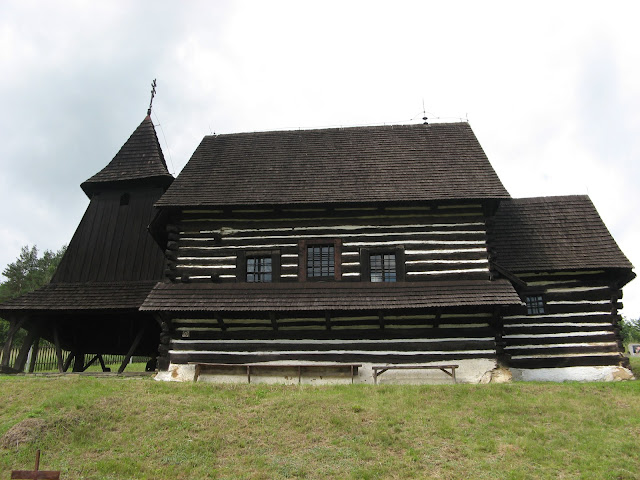This blog is dedicated to the wooden churches and other forms of traditional folk architecture found throughout Central & Eastern Europe, particularly the Carpathian Mountains region in Ukraine, Slovakia, Poland, Romania and the Czech Republic. My eventual goal is to visit and photograph all of these churches, and I will post the photos and a description of each of them here.
Sunday, November 18, 2012
Brežany, Slovakia
This distinctive church sits on a grassy hillside above the small village of Brežany, fifteen kilometres south-west of the city of Prešov. Although it is a Greek-Catholic church, it is located far to the south and west of the region where the majority of these churches can be found in Slovakia along the Polish and Ukrainian borders.
The church was built in 1727 and is dedicated to Saint Lucas the Evangelist. The structure of the building has little in common with other Greek-Catholic churches in north-east Slovakia, since it appears to have features usually associated with Gothic Roman Catholic architectural design (such as the church in Hervartov, Slovakia). It can be assumed that because the Brežany church was built relatively far away from other Rusyn Greek-Catholic churches the construction techniques of the Roman Catholics in the neighbouring villages formed a more significant source of inspiration for the builders.
The floor plan for the church follows the basic three-part system of Greek-Catholic design, with a small sanctuary, the nave as the central room and the narthex (entrance room) represented by a stand-alone bell tower with space for seating beneath it. The bell tower bears a strong resemblance to one exhibited in the outdoor museum in the town of Martin in central Slovakia, while the overall building design is similar to a wooden church in Trnové, a village just outside of Žilina.
The interior contains an iconostasis from 1733, as well as a number of impressive baroque icons. The most important of these icons depicts the coronation of the Mother of God. On the western side of the nave above the door several decorative paintings of biblical scenes can be seen. The front door of the church is also original and dates from the middle of the 18th century. The bell tower contains two large bells which are still in regular use during services.
The jointing system used to connect the ends of the log beams together is very simple (see the photo above), with a small groove cut into the underside of each beam and the ends extended slightly beyond the corners of the building. The gaps between the logs are filled with clay and then whitewashed, creating a striped black and white appearance which is very uncommon among churches in Slovakia, being more commonly seen in northern parts of Moravia and Bohemia.
Beneath the bell tower is a traditional folk object which is very rare now in this part of the Carpathian mountains (see the photo below). This device is used to make a loud repeated sound which would call the villagers to church services. When the handle on the right-hand side is turned it raises a series of wooden slats with wooden hammers attached to the ends of them, causing the hammers to strike the hollow wooden shaft below which then emits a high-pitched sound. These noise makers are similar to the wooden "clappers" traditionally used in the mining towns of central Slovakia (such as Banská Štiavnica) to wake the miners for the morning shift. Similar objects can also be seen in the wooden churches in the Maramures region of north-eastern Romania, further to the east along the Carpathian range.
The key for the church is kept by a family who live down below in the village, near the turning point for the laneway that leads up the hill to the church. Far fewer visitors come to see this church than some of the more well-known Greek-Catholic churches to the north-east, so the family are not used to opening the church for visitors unless an appointment is arranged in advance. Offering them a donation for the church could help in convincing them to come and open it for you.
Brežany village is serviced by a couple of buses per day (fewer on Saturdays and Sundays) which connect it with the central bus station in Prešov. Buses more frequently pass through the village of Rokycany which is a two kilometre walk to the south-east of Brežany. Prešov has frequent train and bus connections with Košice, Bratislava and other major cities throughout Slovakia.
Subscribe to:
Post Comments (Atom)









No comments:
Post a Comment